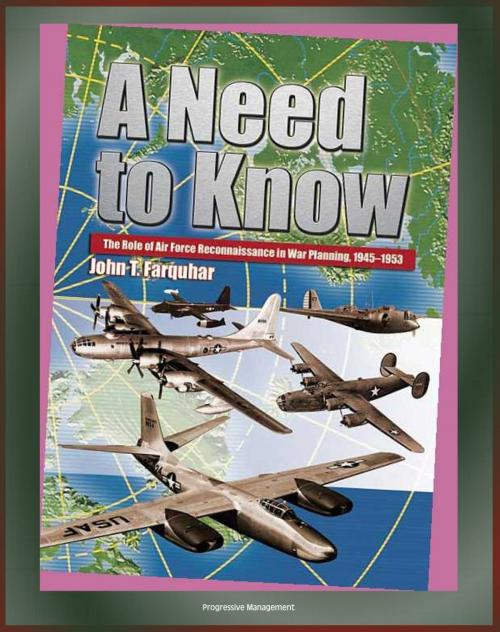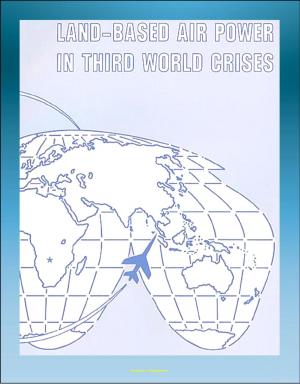A Need to Know: The Role of Air Force Reconnaissance in War Planning, 1945-1953 - Radar Principles, World War I and II, Korean War
Nonfiction, History, Military, Aviation, World War II| Author: | Progressive Management | ISBN: | 9781476297798 |
| Publisher: | Progressive Management | Publication: | July 5, 2012 |
| Imprint: | Smashwords Edition | Language: | English |
| Author: | Progressive Management |
| ISBN: | 9781476297798 |
| Publisher: | Progressive Management |
| Publication: | July 5, 2012 |
| Imprint: | Smashwords Edition |
| Language: | English |
More than a tool of policy makers to gather intelligence, Air Force reconnaissance efforts shaped early Cold War doctrine and war planning. Dr. Farquhar argues that a lack of information on Soviet strategic capabilities dominated the organization, operational planning, and equipment of the postwar Air Force. To support his assertion, Farquhar traces the development of aerial reconnaissance from the first balloon ascents through World War II as a prelude. He then examines early Cold War peripheral reconnaissance and overflights of the Soviet Union. He explains the evolution of intelligence-gathering technology, bureaucratic growth, and a relative lack of attention paid to electronic warfare before the Korean War. Based primarily on archival sources, the book serves as an excellent reference for air doctrine, intelligence, and electronic warfare in the formative years of the Cold War.
At first glance, strategic aerial reconnaissance appears to be a mere technical tool. The term refers to the use of aircraft to collect strategic intelligence using photographic or electronic means. According to the Joint Chiefs of Staff (JCS), strategic intelligence refers to "intelligence that is required for the formation of policy and military plans at national and international lev-els."2 Strategic intelligence includes information provided by sources other than aircraft, including naval vessels, ground communications intercept sites, satellites, published literature, defectors, and spies. Because Air Force aircraft provided the bulk of information used by American war plans from 1945 to 1953, this book focuses on the origins of the USAF strategic aerial reconnaissance.3 Although official JCS publications did not specifically list strategic aerial reconnaissance, the term may be defined as the use of aircraft to gather information necessary to conduct strategic air war, also called strategic air bombardment. At the core of the topic, recently declassified JCS emergency war plans indicate that a strategic air bombardment campaign formed the heart of American military strategy from the end of World War II to the Korean conflict. A study of strategic aerial reconnaissance illuminates the link between intelligence and strategy and between military capability and doctrine. Finally, a focus upon strategic aerial reconnaissance raises questions of ends and means: did reconnaissance aircraft merely serve as a tool of war planners or did strategic reconnaissance actually shape military strategy?
Contents * Introduction * Notes * Chapter 1 * THE ORIGINS OF STRATEGIC AERIAL RECONNAISSANCE * Notes * Chapter 2 * GROPING IN THE DARK: RECONNAISSANCE BEFORE CONTAINMENT, 1945-1946 * Notes * Chapter 3 * FROM CONTAINMENT TO BERLIN: ORGANIZATIONAL STEPS to fill INTELLIGENCE GAPS, 1947-1948 * Notes * Chapter 4 * STRATEGIC BOMBING QUESTIONED: INTELLIGENCE SHORTFALLS AND WAR PLANS, 1949-1950 * Notes * Chapter 5 * THE TEST: STRATEGIC RECONNAISSANCE IN KOREA, 1950-1953 * Notes * Chapter 6 * CONCLUSION * Notes * APPENDIX A * Radar Principles * APPENDIX B * Definitions and Terms
More than a tool of policy makers to gather intelligence, Air Force reconnaissance efforts shaped early Cold War doctrine and war planning. Dr. Farquhar argues that a lack of information on Soviet strategic capabilities dominated the organization, operational planning, and equipment of the postwar Air Force. To support his assertion, Farquhar traces the development of aerial reconnaissance from the first balloon ascents through World War II as a prelude. He then examines early Cold War peripheral reconnaissance and overflights of the Soviet Union. He explains the evolution of intelligence-gathering technology, bureaucratic growth, and a relative lack of attention paid to electronic warfare before the Korean War. Based primarily on archival sources, the book serves as an excellent reference for air doctrine, intelligence, and electronic warfare in the formative years of the Cold War.
At first glance, strategic aerial reconnaissance appears to be a mere technical tool. The term refers to the use of aircraft to collect strategic intelligence using photographic or electronic means. According to the Joint Chiefs of Staff (JCS), strategic intelligence refers to "intelligence that is required for the formation of policy and military plans at national and international lev-els."2 Strategic intelligence includes information provided by sources other than aircraft, including naval vessels, ground communications intercept sites, satellites, published literature, defectors, and spies. Because Air Force aircraft provided the bulk of information used by American war plans from 1945 to 1953, this book focuses on the origins of the USAF strategic aerial reconnaissance.3 Although official JCS publications did not specifically list strategic aerial reconnaissance, the term may be defined as the use of aircraft to gather information necessary to conduct strategic air war, also called strategic air bombardment. At the core of the topic, recently declassified JCS emergency war plans indicate that a strategic air bombardment campaign formed the heart of American military strategy from the end of World War II to the Korean conflict. A study of strategic aerial reconnaissance illuminates the link between intelligence and strategy and between military capability and doctrine. Finally, a focus upon strategic aerial reconnaissance raises questions of ends and means: did reconnaissance aircraft merely serve as a tool of war planners or did strategic reconnaissance actually shape military strategy?
Contents * Introduction * Notes * Chapter 1 * THE ORIGINS OF STRATEGIC AERIAL RECONNAISSANCE * Notes * Chapter 2 * GROPING IN THE DARK: RECONNAISSANCE BEFORE CONTAINMENT, 1945-1946 * Notes * Chapter 3 * FROM CONTAINMENT TO BERLIN: ORGANIZATIONAL STEPS to fill INTELLIGENCE GAPS, 1947-1948 * Notes * Chapter 4 * STRATEGIC BOMBING QUESTIONED: INTELLIGENCE SHORTFALLS AND WAR PLANS, 1949-1950 * Notes * Chapter 5 * THE TEST: STRATEGIC RECONNAISSANCE IN KOREA, 1950-1953 * Notes * Chapter 6 * CONCLUSION * Notes * APPENDIX A * Radar Principles * APPENDIX B * Definitions and Terms















